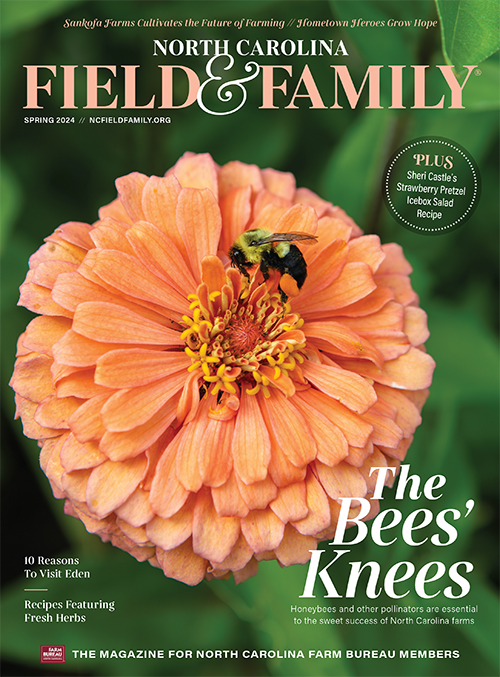North Carolina Smart Farms
Modern technology improves farm efficiency and streamlines conservation efforts.
Nancy Henderson |
Smart technology, such as robots, drones and irrigation software, is changing the way farmers work in North Carolina.
Scaling Back
Fourth-generation farmer Kevin Matthews had been working his family’s land since he was in high school. In 2004, he realized the need to manage his 5,000 acres of corn, soybeans, barley and wheat more efficiently.
Spread across four counties in the Piedmont community of East Bend, the irregularly shaped fields rise steeply in places and consist of soils ranging from beach sand and rich loam to red clay: “you can make a brick out of,” Matthews says.

Utilizing precision agriculture, which divides large plots of land into smaller zones that can be managed individually, Matthews, 43, installed a GPS mapping system and began planting and fertilizing crops with a variable-rate applicator. It delivered only the amount needed in each field, and if one of his helpers missed a spot, it showed up as a white mark on a computer-screen image.
It worked. Crop yields increased, and Matthews reduced the costs of fuel and fertilizer. Mapping, he says, “is just one tool in the toolbox. Even on very small acreages, it will pay back quickly. The mapping is your documentation, your filing cabinet. But it’s in real time.”
In 2011, Matthews became one of the first farmers in the region to install a subsurface drip irrigation (SDI) system. Unlike traditional center-pivot methods, which irrigate crops with sprinkler heads and lose water through evaporation, the low-pressure, underground drip sends the water straight to the plants’ roots. Fertilizer is also injected through the flat tubing.
Though SDI costs roughly $1,200 to $2,000 per acre upfront, the benefits are worth it, says Matthews, who has doubled the corn yield in his upland fields from 150 bushels to 300 using only 13 inches of water; saved money on electricity, water and fertilizer; and helped prevent erosion and leaching of chemicals into nearby streams. He now speaks to farmers across the country about how to use SDI. “We run it up and down hills,” he says. “And it does an excellent job distributing the water evenly all the way across the field.”

Eye in the Sky
When many people think of drones, they imagine military spy tools, package carriers or toys for techies. But they’re also playing an important role in precision agriculture. Technically known as unmanned aerial vehicles (UAVs), the lightweight flying machines take electronic photos and videos of crops and pastures, transmit the data to farmers’ computers, and help them pinpoint problems that might otherwise go overlooked. Unlike satellite technology, which collects images only on certain days and in good weather conditions, drones can fly anywhere, any time, using sensors to provide detailed maps of each field.
3 Ways Drones Help Farmers
1. Monitoring the health of plants in detailed locations to prevent disease or pest infestation from spreading to the rest of the crop.
2. Finding escaped cattle or identifying a sick cow through thermal imaging technology.
3. Producing 3-D maps to analyze soil and help farmers better manage nutrients.
PrecisionHawk, a drone “ecosystem” development company that captures, manages and analyzes data collected by drones from different manufacturers, created its first drone in 2008 to snap aerial photographs of vineyards for the wine industry. Lia Reich, the company’s vice president of marketing and communications, has seen a sharp rise in agricultural use in the last five years. In North Carolina, PrecisionHawk works with farmers to manage specialty crops like tobacco and sweet potatoes.
“You might want to look at how many plants are in your field directly after emergence. We have a plant-counting app for that,” Reich says. “You might want to look at the amount of damage to your field due to water pooling after a storm. We have an app for that.”
But the greatest benefit of drones, Reich points out, is a human one. “One of the things people are saying to us is that this technology is going to keep children on the farm,” she says. “For these multi-generational families that have been growing crops for a long time, the precision ag movement is bringing a new layer of ‘Wow, this is a really data-intensive and smart industry.’ ”

Robots and Beyond
Precision agriculture experts agree that technological advancements are only going to get more sophisticated, and that more and more farmers will use them. Researchers at N.C. State University are experimenting with biobots – live insects fitted with sensors – that can travel where humans cannot. At Metrolina Greenhouses in Huntersville, robots have been used to space, weed, and prune crops, freeing employees to complete other tasks and reducing injuries.
At least one equipment manufacturer has developed a fully autonomous robotic tractor, which, according to Gary Roberson, a technology expert in the biological engineering department at N.C. State University, could reduce costs and boost productivity. A fleet of smaller robots might, in the future, replace one massive combine, reducing worry about breakdowns and covering more ground in less time.
“I don’t think the hands-on nature of farming will ever go away,” Roberson says. “But with technology, we’re giving the farmer more eyes and more hands.”

Protecting the Pollinators
Until recently, it’s been a challenge for large-crop growers and pesticide applicators to avoid spraying too close to neighboring honeybee hives and sensitive specialty crops, such as herbs, organic vegetables, and flowers. Driftwatch, a voluntary online specialty crop-site mapping registry program, and BeeWatch, a registry program for apiaries, are now helping farmers be more vigilant when working near these areas. Members who sign up for the networking programs consult online maps and receive email notices of new specialty crop growers or beekeepers whose businesses are nearby. The real-time alerts can even be downloaded directly into a farmer’s spray rigs.
“Back when I was a kid, we didn’t farm but just a few miles from the house,” says Patrick Jones, deputy director of pesticide programs at the North Carolina Department of Agriculture and Consumer Services. “But nowadays, farmers go in four, five, six counties, even different regions of the state. They just don’t have the opportunity to know all their neighbors like we used to. This map will allow the growers to see those other specialty crops nearby that they may not be aware of.”
North Carolina joined the watch program in April 2016, and more than 1,200 apiaries have already registered, catapulting the state to No. 2 of 13, most of which signed up soon after the programs launched in 2008. “It’s the best tool that we have now for applicators and beekeepers and growers to communicate with each other,” Jones says. “This tool reduces the effects of herbicide drift, and it gives us a chance to do it voluntarily, without mandatory regulations.”
It also brings neighbors together in unexpected ways. In Chatham County, for example, a beekeeper registered her apiary, alerting a nearby cantaloupe farmer who had no idea the hives were there. “They found out the other one was in the same neighborhood and that they benefit from each other,” Jones says. “The bees have the pollination source, and the crop has the pollinators helping them out. The farmer now shares cantaloupes with the beekeeper, and the beekeeper shares honey with the grower.”
– Nancy Henderson


